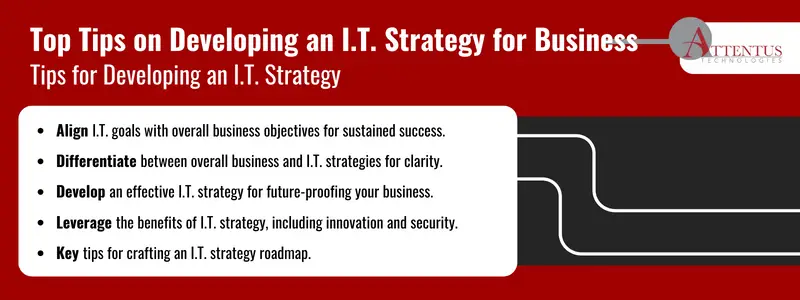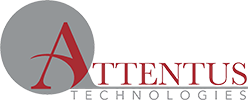Tips for Developing an I.T. Strategy
Modern businesses must practice constant improvement to ensure business success. Constant or continuous improvement means assessing technology, software, I.T. architecture, and taking full advantage of new technology. Businesses run off it. You likely have an overall business strategy. Maybe it even has a section on I.T., but is it enough? Does it align with your overall business goals, or are the two at odds?
Many upper-level executives understand the business but not the I.T. architecture or the importance of integrating new technologies. An I.T. strategy aligned with overall business goals can help demonstrate the importance of I.T. The business can set goals and objectives, but without a robust I.T. strategy outlining a future-oriented plan for adapting to evolving technology, I.T. may quickly veer off course and be outperformed by competitors.
This guide describes what an I.T. strategy is, its benefits, and how to develop an effective I.T. strategy that keeps your business moving forward now and in the future.

What is an I.T. strategy?
An I.T. strategy is a plan for managing technology within the organization and typically includes objectives, goals, and resource planning. It also ensures that I.T. goals are aligned with overall business objectives, ensuring sustained success.
A typical I.T. strategy includes:
- Selected technology options across the I.T. infrastructure.
- Budgeting
- Defining where your current technology needs improvement.
- A 3-year and 5-year plan.
- Resource planning
- Risk management and cybersecurity plans
An effective I.T. strategy keeps the organization on track to meet business goals by defining where and when I.T. spending will occur; it guides the deployment of new technology and ensures there is a plan for every new implementation. Crafting an I.T. strategy places your business at a strategic advantage, surpassing a majority of competitors. Numerous organizations neglect the important task of planning for I.T., often lacking a comprehensive understanding of their existing technological assets, capabilities, and limitations.
An I.T. strategy is a roadmap guiding the business on technology investments for constantly improving business operations. A solid I.T. roadmap identifies and assesses current software applications, database schemas, devices, and server systems and defines a future-looking plan for each. Are there new technologies you can leverage to improve productivity? What about increasing cost-effectiveness through business process automation?
As you map out an I.T. strategy roadmap, focus on anticipating future business needs with a commitment to continuous improvement. If you need assistance with your I.T. strategy, consider partnering with Attentus. They not only help manage your current and future I.T. needs but also prioritize ongoing improvement for both their business and yours.
Benefits of an I.T. strategy for future-proofing your business
The primary benefits of an I.T. strategy include:
- Identifying realistic opportunities for innovation with technology.
- Effectively managing security needs to prevent loss or theft.
- Keeping pace with the competition by adopting new technology or innovative approaches.
- Investing for growth without breaking the I.T. budget.
- Constantly improving business operations by prioritizing I.T. changes and improvements.
Despite current economic and social turbulence, worldwide I.T. spending at the end of 2023 reached $4.6 trillion, a 5.5% increase over the prior year. With businesses spending so heavily on tech, you need a strong I.T. strategy to stay competitive. If this all seems overwhelming, that’s because it can be. Fortunately, there’s help. Attentus can be your best investment for seeking constant improvement.
Developing an effective I.T. strategy
Tips for developing an exceptional I.T. strategy include:
- Incorporate business goals and set specific I.T. initiatives.
- Include the desired outcome. For example, improved customer service levels, increased productivity, or reduced manual processes.
- Assess your current I.T. infrastructure.
- You must understand what you currently have and how I.T. can be best utilized or upgraded.
- Ensure your I.T. initiatives are compatible with your technology base or plan to change it.
- Develop a scope, schedule, and budget for each initiative or goal.
- Define what will be changed and what remains.
- Create a roadmap for the next 3-5 years.
- You can always go longer or shorter. Be sure to update it regularly.
- Plan for metrics to measure the success of each project in meeting the goal.
- Metrics provide proof of success or the need to change a goal.
- Metrics provide useful data for business analytics and data-driven decision-making.
- Set a budget.
- Be realistic about what you can invest.
- Put I.T. initiatives in priority order.
- Prioritize based on what is truly needed now and what can wait.
- Revise it and update the strategy continuously.
- Your I.T. strategy is a living document that will change based on new technologies available, changes in regulatory requirements, or even security protocols.
- Keep it handy and keep it updated.
You can trust Attentus to manage the I.T. strategy development and management process. Our team is experienced in assessing I.T. systems and developing effective I.T. strategies that will move your business into the future with constant and consistent improvement.
Move your business forward with I.T. strategy support from Attentus
Choose Attentus and let us be an active partner in your business growth and success. As a leading provider of I.T. services in the Seattle area, we can make your I.T. management exceptionally effective without being scary or overwhelming. I.T. strategy is a lot to take on. Do it with a trusted partner who believes in seeking constant improvement and personalized, focused service.
Rely on Attentus to oversee your I.T. strategy, starting with an assessment and guidance in crafting an effective plan. Maintain control without delving into every I.T. detail. Through proactive communication and collaboration, we ensure your business operates at its best now and in the future. Receive an accurate price quote within 30 minutes.



